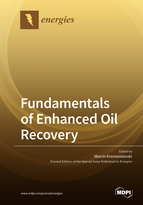Fundamentals of Enhanced Oil Recovery
A special issue of Energies (ISSN 1996-1073). This special issue belongs to the section "H1: Petroleum Engineering".
Deadline for manuscript submissions: closed (20 January 2022) | Viewed by 28350
Special Issue Editor
Interests: well drilling technology; wellbore stability; cement sheet microstructure; enhanced oil and gas recovery; solid waste management; environmental science; unconventional resources; renewable energy
Special Issues, Collections and Topics in MDPI journals
Special Issue Information
Dear Colleagues,
For many years, there has been a clear trend of increasing energy demand. Despite the search for alternative energy sources, it is estimated that oil and natural gas will be the main source of energy in transport for the next several dozen years. However, the reserves of renewable raw materials are limited in volume. Along with the degree of depletion, oil recovery becomes increasingly difficult, even though the deposits are not yet completely empty. Therefore, it is essential to find new methods to increase oil and gas recovery. Actions aimed at intensifying oil recovery are a very rational use of energy that has not yet been fully used.
Usually, an increase in oil recovery can be achieved by using extraction intensification methods. However, measures to increase oil recovery can be implemented and carried out at any stage of the borehole implementation—starting from the well design stage, through drilling, and ending with the exploitation of oil and gas. Therefore, in order to further disseminate technologies and methods related to increasing oil recovery, this Special Issue, entitled “Fundamentals of Enhanced Oil Recovery”, has been proposed for the international journal Energies, which is indexed by SSCI and SCIE (2019 IF = 2.702). This Special Issue will mainly cover original research and studies on the above-mentioned topics, including but not limited to improving the efficiency of oil recovery, improving the correct selection of drilling fluids, secondary methods of intensifying production, appropriate energy management in the oil industry, and so on. Papers selected for this Special Issue will be subject to a rigorous peer-review procedure with the aim of rapid and wide dissemination of research results, developments, and applications.
I am writing to invite you to submit your original work to this Special Issue. I look forward to receiving your outstanding research.
Dr. Marcin Kremieniewski
Guest Editor
Manuscript Submission Information
Manuscripts should be submitted online at www.mdpi.com by registering and logging in to this website. Once you are registered, click here to go to the submission form. Manuscripts can be submitted until the deadline. All submissions that pass pre-check are peer-reviewed. Accepted papers will be published continuously in the journal (as soon as accepted) and will be listed together on the special issue website. Research articles, review articles as well as short communications are invited. For planned papers, a title and short abstract (about 100 words) can be sent to the Editorial Office for announcement on this website.
Submitted manuscripts should not have been published previously, nor be under consideration for publication elsewhere (except conference proceedings papers). All manuscripts are thoroughly refereed through a single-blind peer-review process. A guide for authors and other relevant information for submission of manuscripts is available on the Instructions for Authors page. Energies is an international peer-reviewed open access semimonthly journal published by MDPI.
Please visit the Instructions for Authors page before submitting a manuscript. The Article Processing Charge (APC) for publication in this open access journal is 2600 CHF (Swiss Francs). Submitted papers should be well formatted and use good English. Authors may use MDPI's English editing service prior to publication or during author revisions.
Keywords
- increasing the efficiency of oil recovery
- improved borehole sealing
- correct selection of drilling fluids
- reducing energy consumption
- appropriate energy management in the oil industry
- new technologies supporting the efficiency of recovery
- technical and technological challenges
- operational challenges
- Innovative technologies in oil drilling






